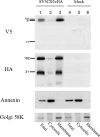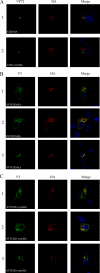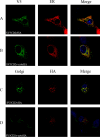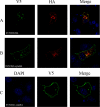Processing and localization of the african swine fever virus CD2v transmembrane protein
- PMID: 21248037
- PMCID: PMC3067853
- DOI: 10.1128/JVI.01994-10
Processing and localization of the african swine fever virus CD2v transmembrane protein
Abstract
The African swine fever virus (ASFV)-encoded CD2v transmembrane protein is required for the hemadsorption of red blood cells around infected cells and is also required for the inhibition of bystander lymphocyte proliferation in response to mitogens. We studied the expression of CD2v by expressing the gene with a V5 tag downstream from the signal peptide near the N terminus and a hemagglutinin (HA) tag at the C terminus. In ASFV-infected cells, a full-length glycosylated form of the CD2v protein, which migrated mainly as a 89-kDa product, was detected, as well as an N-terminal glycosylated fragment of 63 kDa and a C-terminal nonglycosylated fragment of 26 kDa. All of these forms of the protein were localized in the membrane fraction of cells. The 26-kDa C-terminal fragment was also produced in infected cells treated with brefeldin A. These data indicate that the CD2v protein is cleaved within the luminal domain and that this occurs in the endoplasmic reticulum or Golgi compartments. Confocal microscopy showed that most of the expressed CD2v protein was localized within cells rather than at the cell surface. Comparison of the localization of full-length CD2v with that of a deletion mutant lacking all of the cytoplasmic tail apart from the 12 membrane-proximal amino acids indicated that signals within the cytoplasmic tail are responsible for the predominant localization of the full-length and C-terminal 26-kDa fragment within membranes around the virus factories, which contain markers for the Golgi compartment. Processing of the CD2v protein was not observed in uninfected cells, indicating that it is induced by ASFV infection.
Figures







Similar articles
-
The CD2v protein of African swine fever virus interacts with the actin-binding adaptor protein SH3P7.J Gen Virol. 2004 Jan;85(Pt 1):119-130. doi: 10.1099/vir.0.19435-0. J Gen Virol. 2004. PMID: 14718626
-
From structure prediction to function: defining the domain on the African swine fever virus CD2v protein required for binding to erythrocytes.mBio. 2025 Feb 5;16(2):e0165524. doi: 10.1128/mbio.01655-24. Epub 2024 Dec 17. mBio. 2025. PMID: 39688401 Free PMC article.
-
The recombinant pseudorabies virus expressing African swine fever virus CD2v protein is safe and effective in mice.Virol J. 2020 Nov 16;17(1):180. doi: 10.1186/s12985-020-01450-7. Virol J. 2020. PMID: 33198749 Free PMC article.
-
CD2v Interacts with Adaptor Protein AP-1 during African Swine Fever Infection.PLoS One. 2015 Apr 27;10(4):e0123714. doi: 10.1371/journal.pone.0123714. eCollection 2015. PLoS One. 2015. PMID: 25915900 Free PMC article.
-
African swine fever virus proteins involved in evading host defence systems.Vet Immunol Immunopathol. 2004 Aug;100(3-4):117-34. doi: 10.1016/j.vetimm.2004.04.002. Vet Immunol Immunopathol. 2004. PMID: 15207450 Review.
Cited by
-
Development of an indirect ELISA for the identification of African swine fever virus wild-type strains and CD2v-deleted strains.Front Vet Sci. 2022 Sep 8;9:1006895. doi: 10.3389/fvets.2022.1006895. eCollection 2022. Front Vet Sci. 2022. PMID: 36157191 Free PMC article.
-
First detection of African swine fever (ASF) virus genotype X and serogroup 7 in symptomatic pigs in the Democratic Republic of Congo.Virol J. 2020 Sep 3;17(1):135. doi: 10.1186/s12985-020-01398-8. Virol J. 2020. PMID: 32883295 Free PMC article.
-
Roles of African Swine Fever Virus Structural Proteins in Viral Infection.J Vet Res. 2017 Dec 6;61(2):135-143. doi: 10.1515/jvetres-2017-0017. eCollection 2017 Jun. J Vet Res. 2017. PMID: 29978065 Free PMC article.
-
African Swine Fever Virus CD2v Protein Induces β-Interferon Expression and Apoptosis in Swine Peripheral Blood Mononuclear Cells.Viruses. 2021 Jul 28;13(8):1480. doi: 10.3390/v13081480. Viruses. 2021. PMID: 34452346 Free PMC article.
-
African swine fever virus MGF-360-10L is a novel and crucial virulence factor that mediates ubiquitination and degradation of JAK1 by recruiting the E3 ubiquitin ligase HERC5.mBio. 2023 Aug 31;14(4):e0060623. doi: 10.1128/mbio.00606-23. Epub 2023 Jul 7. mBio. 2023. PMID: 37417777 Free PMC article.
References
-
- Arias, M., and J. M. Sanchez-Vizcaino. 2002. African swine fever, p. 119-124. In A. Morilla Gonzaìlez, K.-J. Yoon, and J. J. Zimmerman (ed.), Trends in emerging viral infections of swine. Iowa State Press, Ames, IA.
-
- Barclay, A. N. 2001. Biochemical analysis of the lymphocyte cell surface—from alloantisera to the role of membrane proteins. Immunol. Rev. 184:69-81. - PubMed
-
- Bodian, D. L., E. Y. Jones, K. Harlos, D. I. Stuart, and S. J. Davis. 1994. Crystal structure of the extracellular region of the human cell-adhesion molecule cd2 at 2.5-Angstrom resolution. Structure 2:755-766. - PubMed
-
- Boinas, F. S., G. H. Hutchings, L. K. Dixon, and P. J. Wilkinson. 2004. Characterization of pathogenic and non-pathogenic African swine fever virus isolates from Ornithodoros erraticus inhabiting pig premises in Portugal. J. Gen. Virol. 85:2177-2187. - PubMed
Publication types
MeSH terms
Substances
Grants and funding
LinkOut - more resources
Full Text Sources
Other Literature Sources

